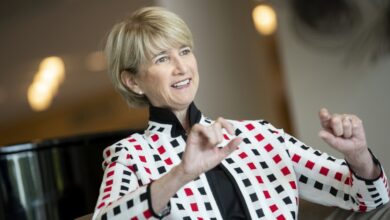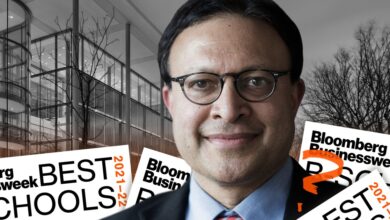How 3 Colleges Are Trying to Remedy Enrollment Woes

[ad_1]
The sectorwide drop in undergraduate enrollment over the past decade isn’t happening on every campus. But for some — particularly small private institutions, public regionals, and community colleges — the declines have often been acute. Here’s how three such institutions have felt the effects of sliding enrollment, the choices they’ve made in the past, and how they’re hoping to halt the downward trend.
A Roman Catholic institution of 955 undergraduate and graduate students in Clayton, Mo., which borders St. Louis, Fontbonne was once a women’s college. That changed in the 1960s.
More recently, as Fontbonne has faced enrollment declines, it has tried other tactics. Cutting staff. Adding academic programs. Acquiring (then selling) land. It has even started an unusual football program.
The pandemic had a sobering effect on student numbers: In 2021, Fontbonne’s freshman-class size dropped 35 percent, and overall enrollment fell by 14 percent. Quinton Clay, vice president for enrollment management, marketing, and communications, said that the inability to recruit students in person played a significant role. An on-campus visit “is one of the strongest drawing cards for students and families to choose this institution,” he said.
But Fontbonne’s challenges are not new: From 2006 to 2016, undergraduate enrollment dropped by more than 45 percent, with the number of Black students declining by nearly 75 percent for part of the same period. Fontbonne, like other small colleges, is not at the “robust endowment end of the spectrum,” Clay pointed out, so it relies on tuition for much of its revenue. (The university’s endowment stood at $16.8 million, according to its 2021 financial statement.) For at least the past two years, Fontbonne’s core operations failed to generate positive revenue; it relied on pandemic-related government relief funds to finish its 2021 fiscal year in the black.
In 2020 the university submitted petitions to the Missouri attorney general and gained access to nearly $5 million worth of donor-restricted endowment funds for scholarships. In 2018 the university laid off 27 employees — or about 10 percent of its work force — to save $1.3 million annually. Those reductions were enacted under the previous president, and Nancy H. Blattner, who took over in July 2020, said she doesn’t anticipate making any more staffing cuts. Under the previous president, Fontbonne also bought a former high-school property for $20 million to create athletic fields and adult-education classrooms. Fontbonne sold the property in November 2021.
“We’re investing all of our resources and energy into the Clayton campus instead of dividing it between two spaces,” Blattner said. “That was another president’s dream, and he was entitled to that, but it wasn’t mine.”
Blattner has a different vision. Part of it still involves athletics — but centers on a specific kind of football team.
It’s called sprint football, a weight-restricted version of the sport, in which players must weigh 178 pounds or less to be eligible. Blattner said Fontbonne would build up to recruiting 80 men to play on its team.
Before Blattner became president of Fontbonne, she led Caldwell University, in New Jersey. Under her leadership, Caldwell joined what was then considered the only sprint-football league in the United States.
“It brought more diversity to campus. It brought a gender balance because, like Fontbonne, Caldwell also began as a women’s college,” Blattner said. “The student vibrancy on campus around the football team was really exciting. And frankly, it attracted our alums and even some donors that were willing to give to football that hadn’t been interested in participating in that way.”
She wanted to employ the same strategy when she arrived at Fontbonne, but the sprint-football league that Caldwell belonged to included only teams on the East Coast. “We’re a thousand miles away,” Blattner said. “So it was really impractical to think we could drive.”
So she decided to start her own: the Midwest Sprint Football League. It has six colleges ready to compete this fall, and others have contacted her to join in 2023.
Blattner expects that 40 to 45 men will come to Fontbonne to play sprint football this fall. “Frankly,” she said, these students “would not be here for any other reason except they want to continue to do something that they excelled at in high school, but they’re simply, through their stature, not able to compete in a D-I, D-II, D-III, or NAIA school on a regular football team.”
But sprint football is just one of many ways the university is trying to raise enrollment and revenue.
Fontbonne adopted a test-blind admissions policy for this fall’s incoming freshmen, making it the only college in Missouri to do so, according to FairTest, a group that seeks to curb inequities related to standardized testing. Clay said the university had its second-largest applicant pool for freshmen — but he said it would be “premature” to give specific details on whether that will translate into an increase in enrollment. The policy is about more than enrollment anyway, Clay said. “Removing barriers in terms of students doing the legwork,” especially first-generation students, is “really, really critical and important.”
Fontbonne is also restructuring its academic offerings to attract more students. A criminal-justice major is awaiting approval from the university’s accreditor. And the university will begin offering an undergraduate nursing program in the fall of 2022.
“We try to meet the needs of what the students are interested in studying, and those things change over time,” Blattner said. “It’s an evolution.”
According to Blattner, the costs for the nursing program and the sprint football team are covered by alumni donations. (When asked about the specific costs of the programs, Clay declined via email to provide the details.)
Blattner also believes the future for higher education, especially for smaller colleges, lies in partnerships. In the fall of 2021, Fontbonne began offering its graduate program in speech and language pathology at Avila University, in Kansas City, Mo. In 2023, it will do the same with St. Catherine University, in St. Paul, Minn.
“When we’re small, we don’t have to reinvent the wheel,” Blattner said. “We can share what we have with other institutions, and students in both locations can benefit.” —B.H.
Unlike many regional public colleges, though, Adams State is located in an area of the country that’s growing rather than shrinking. Colorado and Alamosa County have seen increases in their population, according to the most recent census data. The college’s struggles with low retention and graduation rates, and competition from other public institutions, have made it difficult to sustain the size of its student body. The decline has had other effects: Adams State eliminated 27 positions to reduce personnel costs by $2.2 million in 2018. Most of the reductions were voluntary, though nine people lost their jobs.
The college hopes to find a solution by hewing close to the mission it shares with many regional public colleges: to expand access to postsecondary education, promote equity, and act as “stewards of their local communities,” said Cecilia M. Orphan, an associate professor of higher education at the University of Denver and director of partnerships for the Alliance for Research on Regional Colleges, which classifies Adams State as a rural-serving institution. It is trying to stave off further enrollment declines by recommitting itself to the local community and the students it serves.
“We have an obligation to do things well, not just to our students, which is our top priority, but also to our community, our regional community, which is so dependent on us when it comes to driving the economy, providing workers, being a source of culture, entertainment, education, and the like,” said David A. Tandberg, who was recently appointed to a one-year interim presidency after serving on the university’s Board of Trustees. “So we’ve got to figure this thing out.”
The interim presidency came with the condition that whoever was appointed would not be eligible to become the next president. Tandberg said that limitation is freeing because it allows him to focus on the issues the university faces instead of campaigning for the permanent job.
The biggest obstacle to enrolling more undergraduates may be the competition Adams State faces from other colleges. “We’re in a particularly competitive marketplace where the flagship research universities tap into our markets,” he said. “They’re very hard to compete against.”
Tandberg, who was previously senior vice president for policy research and strategic initiatives at the State Higher Education Executive Officers Association, said the university needs to create better partnerships with local community colleges and high-school districts. High-school students, he said, need absolute clarity on what it takes to go to college. That means removing the bureaucracy that often comes with applying.
“In the San Luis Valley, we can literally tell every student that is going to graduate from high school that they’re admitted to Adams State,” he said. “All you got to do is complete. I don’t care what your grades are. You’re admitted to Adams State.”

Delcan & Co. + Danielle Del Plato for The Chronicle
Increasing enrollment, though, is only one step. The university has a 59-percent retention rate and a 38-percent graduation rate, which it is seeking to improve by better supporting students, many of whom are the first in their families to attend college. Recently, Adams State has bolstered its student-success efforts and changed academic offerings. It has created broadly focused “metamajors,” reshaped the curriculum, and made the experience for students more inclusive.
As the student body has grown more diverse — 36 percent of Adams State undergraduates are Hispanic, and half come from underrepresented groups — it became clear to faculty members that the curriculum needed to reflect the students, said Matthew Valverde, an associate professor of voice and the project director for Title V grants at the university.
With funds from the federal government and buy-in from the faculty, the Adams Experience kicked off in 2020. The project includes a first-year seminar, eportfolios, capstone projects, reflections after courses, and more, to help students find their community on campus, understand the real-world uses of their education, and have a place to display to potential employers what they have done in college. The Adams Experience also created more internships for students and a peer-mentoring program.
“We’re really focused on, once the students are here, holding onto them and making them feel uplifted and feel affirmed,” Valverde said. “And of course, to learn a lot and have a really good experience all over our campus and throughout the Valley.”
The university has also created “metamajors” to bolster some of Adams State’s programs that weren’t recruiting well and give students more interdisciplinary options, said Colleen M. Schaffner, chair of the psychology department and director of the School of Humanities and Social Sciences. Schaffner oversaw the development of two metamajors in the social sciences, one focusing on prelaw and the other on forensics.
Ideally, the two new majors will enable fewer students to enter the university undeclared and ensure more of them don’t lose credits toward their degree if they switch majors. While it’s too soon to determine how these changes will affect retention, Schaffner has seen encouraging signs, like students in metamajors being in more-frequent contact with their peers in the program. The changes have also helped attract some students to the social sciences, she said.
Ultimately, Adams State will be judged on how well it achieves its mission, “to provide equitable access to education for all,” which is part of what drew some administrators and faculty members there — faculty members like Charles Nicholas Saenz.
“Being Latino myself, I was really excited about that idea of working at an institution that was not just about research, but really leaning into educating the next generation and providing a public service,” said Saenz, a professor of history and president of the Faculty Senate. “It wasn’t just about generating wealth but actually cultivating an entire population to succeed.” —W.M.
Enrollment in the sector had decreased by more than 16 percent as of the spring of 2022, with students of color accounting for most of the drop, according to the National Student Clearinghouse Research Center. More recently, as inflation and the cost of living have risen, people who might otherwise attend community college are focused on finding jobs to cover their immediate expenses. That’s why many of the institutions are making support services more available and conducting outreach to keep their enrollments up.
Take Quinsigamond Community College, in Worcester, Mass., for example. Quinsigamond experienced an 18-percent drop in head count from 2014 to 2021.
The enrollment decline, said Luis G. Pedraja, Quinsigamond’s president, has resulted in lost revenue for food vendors and the campus bookstore. The college also laid off at least 12 part-time and full-time employees at the Children’s School, Quinsigamond’s early-childhood-education lab school, during the summer of 2020, though they were later rehired, according to the Massachusetts Teachers Association.
To combat the decline, the college has focused on retaining its existing students by bolstering support services: hiring a career-success counselor, making additional mental-health resources available, and spending more on its food pantry.
“We feel like we’ve gone from just being an educational facility to being more of a center for serving the community in general through social services, as well as education,” Pedraja said.
The food pantry has expanded both in size and in the volume of donations it receives since it started, in 2018, said Terry Vecchio, dean of students. It serves 451 students, making it one of the most heavily used pantries in the area, she said.
Vecchio said the pantry had received grateful letters and emails from members of the community and from students who have said that the pantry’s services allowed them to focus more on their academics instead of worrying about where to find the next meal for themselves and their families.
“It wasn’t unusual for our students to be struggling prior to Covid,” she said. “During Covid, it was much more challenging for students to get their basic needs met.”
The pantry has also served as a central resource for other services and referrals the college can provide. Staff members have offered access to a law office that helps students with housing or immigration law, or to financial-literacy classes to teach students how to manage their money. Vecchio doesn’t anticipate that funding for the pantry will disappear if or when enrollment improves; the needs that the food pantry seeks to meet existed before the pandemic and have only been exacerbated since it began.
“This is not an issue that is going to go away for college students,” she said.
It’s too soon to tell if Quinsigamond’s efforts have had an effect on retention. Between the fall semesters of 2019 and 2021, the retention rate held steady at 50 percent, though that represented a four-percentage-point drop from the previous two years.
To be sure, Quinsigamond is also pursuing more-traditional avenues to bolster enrollment, including conducting targeted outreach through advertisements at barbershops and the local department of motor vehicles.
But the focus on providing social services to shore up enrollment is an “excellent” use of resources, said NT Izuchi, president of Quinsigamond’s Faculty Senate. He’s watched food insecurity run rampant since the pandemic hit, he said.
“I’ve been in the classroom for about three decades, said Izuchi, a professor of computer systems and engineering technology, “and I’ve never seen the type of challenges we’ve seen in the past two and a half years.”
In some ways, community colleges in Massachusetts seeking to reverse their enrollment drops are fighting an uphill battle, said Nate Mackinnon, executive director of the Massachusetts Association of Community Colleges. Many residents, he said, choose to leave the state when they reach their 20s because of the high cost of living.
“It’s not the fault of community colleges in Massachusetts or anywhere else in the country,” Mackinnon said. “Rather, it’s very much a result of external forces that our students are faced with, decisions they have to make, in terms of how they prioritize their time and energy.”
But community colleges aren’t without choices, either. Mackinnon said that many of the state’s community colleges are making funds for short-term certificate programs a priority.
Quinsigamond has invested $2.7 million in Massachusetts work-force-development grants in programs like the college’s free “fast-track skills academy” which provides job training in as few as 75 hours. The program trains students for careers in about a dozen fields with high employer demand but a low supply of candidates, like clinical medical assistants or back-end software development.
“It’s apparent right now that we have quite the gap between … skilled employees in high-skilled industries and the available labor pool,” Mackinnon said. ”That’s where community colleges can really fill the void.” —I.T.
Dan Bauman contributed to this report.
[ad_2]
Source link







